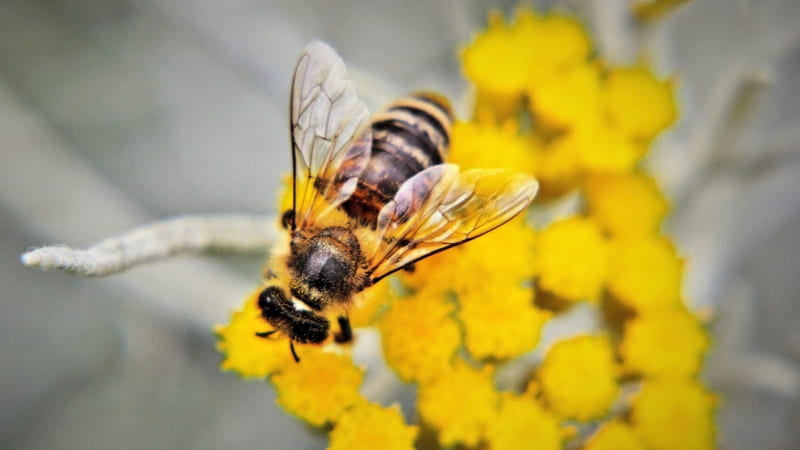WON’T YOU BEE MY NEIGHBOR?: PART 1
By: Hannah Gavin

“If I was a flower growing wild and free, all I’d want is you to be my sweet honey bee.” – Barry Louis Polisar
Question: What do mustard, pickles, and hot peppers have in common?
Answer: In addition to being united atop a properly dressed Chicago-style hot dog, each of the foods mentioned above – and an annual total of $15 billion in U.S. crops – is made possible by the diligent work of bees.
When it comes to the food supply chain, farmers must sow seeds so that plants sprout and grow. But without bees, the seeds responsible for more than 30 percent of global crops would never have been produced in the first place.
Like humans, plants reproduce sexually, meaning that two parents must contribute genetic material to produce offspring. Male and female gametes need to meet in order to produce the seed for a new plant. However, there is a physical barrier to offspring production. Pollen – the plant equivalent of sperm – is produced in flower stamen, separate from the stigma where the equivalent of an egg is housed. Instead of taking their chances on a favorable wind blowing pollen from stamen to stigma, many plants have employed a third party – a pollinator – to act as a flying go-between.
What is it that entices bees, butterflies, birds or bats to participate in this vegetal ménage a trois? Plants offer up a beguiling buffet of sweet nectar and protein-rich pollen in the pleasing setting of brightly colored flowers. In exchange for a feast, a bee can carry pollen stuck to her legs or abdomen among the thousands of flowers she may visit in a single day. Thus, what is to bees an easy task accompanying food acquisition is to plants an essential step in species survival and to humans a key process in agricultural production.
One in every three bites of food is credited to pollinators, such as bees, according to the North American Pollinator Protection Campaign (NAPPC). A summery bowl of peaches and berries for breakfast comes courtesy of bees. Carrots or cucumbers enjoyed with lunchtime hummus need bees. Happy hour guacamole would be a sad bowl of salty lime juice without pollinators. The greasy deliciousness of corndogs, donuts, and fried chicken is made possible by bees’ pollination of the canola plant, source of the popular frying oil. Bees allow for the apple or pumpkin pie filling in the classic desserts and the nuts in an Almond Joy.
Even deciding to fast for a day doesn’t mean escaping the influence of the bee. Sixty eight percent of women’s and 85 percent of men’s clothing contains cotton – a bee-pollinated crop. So not only do bees feed the country, they clothe the country, too. Bee byproducts such as honey and beeswax are used in natural cosmetics. The components of bee venom are even a source of potential medical advances.
Knowing all this, it becomes quite evident that bees are important! Distressingly, the number of bees lost in the United States in 2014-2015 was the second highest in recorded history at 42.1 percent of managed colonies nationwide. What is now labeled Colony Collapse Disorder (CCD) began in 2006 and has become the subject of much research in the academic and agricultural sectors. CCD has garnered enough attention, in fact, that the President of the United States is getting in on the act to ensure that tiny insect members of the American workforce can continue their big impact on the nation’s economy, food supply, and natural ecological diversity.
Click here to read our next installment about bee colonies, federal efforts for the bees, and interesting ways that Chicago city dwellers can help pollinators without ever leaving the concrete jungle.
